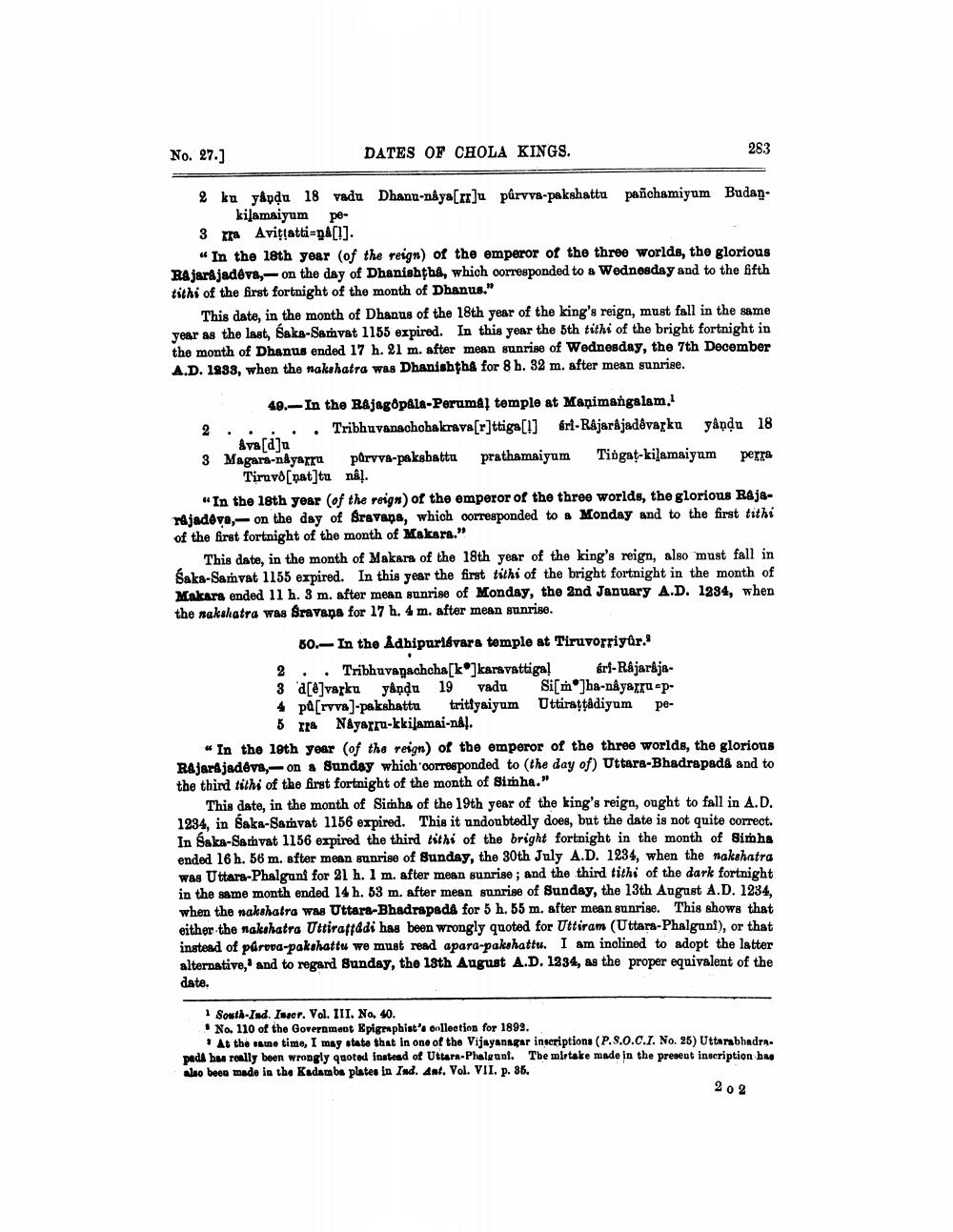________________
No. 27.]
DATES OF CHOLA KINGS.
283
2 ku yâpdu 18 vadu Dhanu-naya[rI]u pûrvva-pakshattu pañchamiyum Budaq.
kilamaiyum pe3 zra Avitatti=&[1].
“In the 18th year (of the reign) of the emperor of the three worlds, the glorious Rajarajadáva, on the day of Dhanishtha, which corresponded to a Wednesday and to the fifth tithi of the first fortnight of the month of Dhanus."
This date, in the month of Dhanus of the 18th year of the king's reign, must fall in the same year as the last, Saka-Samvat 1155 expired. In this year the 5th tithi of the bright fortnight in the month of Dhanus ended 17 h. 21 m. after mean sunrise of Wednesday, the 7th December A.D. 1998, when the nakshatra was Dhanishtha for 8 h. 32 m. after mean gunrise.
49.- In the Rajagopala-Perumal temple at Manimangalam.! 2 .. . . Tribhuvanachohakrava[r]ttiga[1] Sri-Rajarajaddvarku gându 18
Svadu 3 Magara-nåyarru pārvva-paksbattu prathamaiyum Tingat-kilamaiyam perra
Timvo[nat]tu nál. "In the 18th year of the reign) of the emperor of the three worlds, the glorious Rajanajadeva,- on the day of Sravana, which corresponded to a Monday and to the first tithi of the first fortnight of the month of Makara."
This date, in the month of Makars of the 18th year of the king's reign, also must fall in Saka-Samvat 1155 expired. In this year the first tithi of the bright fortnight in the month of Makars ended 11 h. 3 m. after mean sunrise of Monday, the 2nd January A.D. 1994, when the nakshatra was Sravana for 17 h. 4 m. after mean sunrise.
60.-- In the Adhipuri vara temple at Tiruvorriyûr. 2 . Tribhuvagachcha[k]karavattiga! śrf-Rajaraja3 a[@]varkı yându 19 vadu Si[m]ha-ngyarru ep4 på[rvva]-pakshattu tritiyaiyum Uttirattádiyum pe
5 fra Nayarru-kkilamai-nal. * In the 19th year of the reign) of the emperor of the three worlds, the glorious RAardjadeva, - on a Sunday which corresponded to the day of) Uttara-Bhadrapad& and to the third tithi of the first fortnight of the month of Simha."
This date, in the month of Simha of the 19th year of the king's reign, ought to fall in A.D. 1234, in Saka-Samvat 1156 expired. This it undoubtedly does, but the date is not quite correct. In Baka-Samvat 1156 expired the third tithi of the bright fortnight in the month of Simha ended 16 h. 56 m. after mean sunrise of Sunday, the 30th July A.D. 1234, when the nakshatra was Uttara-Phalgani for 21 h. 1 m. after mean sunrise ; and the third tithi of the dark fortnight in the same month ended 14 h. 53 m. after mean sunrise of Sunday, the 13th August A.D. 1234, when the nakshatra was Uttara-Bhadrapada for 5 h.55 m. after mean sunrise. This shows that either the nakshatra Uttiraffddi has been wrongly quoted for Uttiram (Uttara-Phalgani), or that instead of parova-pakshattu we must read apara-pakshattu. I am inclined to adopt the latter alternative, and to regard Sunday, the 18th August A.D. 1234, as the proper equivalent of the date.
1 South-Ind. Inger. Vol. III. No. 40. . No. 110 of the Government Epigraphist's collection for 1893.
At the rame time, I may state that in one of the Vijayanagar inscriptions (P.S.O.C.I. No. 25) Uttarabhadra. pada has really been wrongly quoted instead of Uttara-Phalgunf. The mistake made in the present inscription ne lao been made in the Kadamba plates in Ind. Ant. Vol. VII. p. 86.
2 0 2




